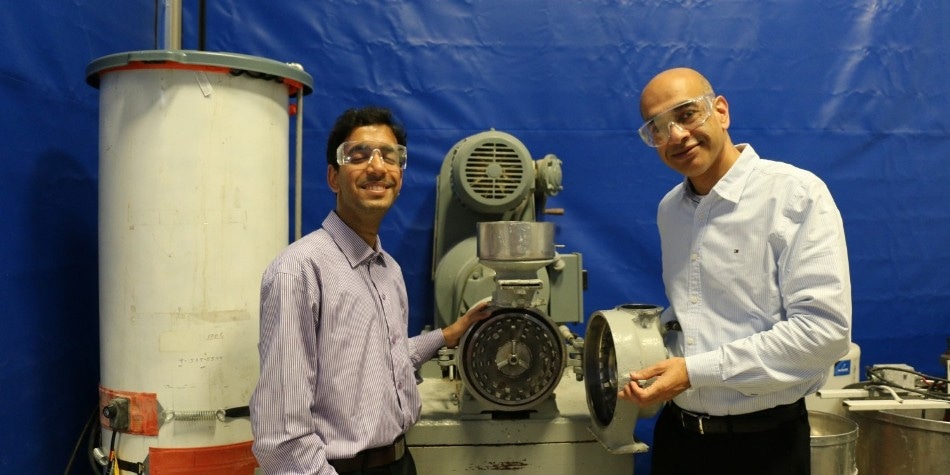Nov 5 2019
With over 200 commercial plants processing more than 16 billion gallons annually, the United States is the world’s leading producer of bioethanol as a renewable liquid fuel.
 Chinmay Kurambhatti (left) and Vijay Singh show a pilot plant wet fractionation corn grinding mill at the Integrated Bioprocessing Research Laboratory. (Credit: University of Illinois)
Chinmay Kurambhatti (left) and Vijay Singh show a pilot plant wet fractionation corn grinding mill at the Integrated Bioprocessing Research Laboratory. (Credit: University of Illinois)
In general, these plants use dry grind processing techniques; however, executing fractionation methods that separate corn components before fermentation can enhance profitability, as revealed by research performed at the University of Illinois.
In the traditional dry grind process, starch obtained from mashed corn is hydrolyzed to synthesize glucose, which is then fermented into ethanol. Corn oil and distiller’s dried grain with solubles (DDGS) are the byproducts of this process.
These byproducts help balance the production cost of ethanol. However, due to their low quality, dry grain processors lose a substantial revenue resource, stated Chinmay Kurambhatti, a doctoral student in Agricultural and Biological Engineering at U of I and lead author on the study.
DDGS consists of low protein and high fiber content and is typically used for ruminant feeding. The corn oil can be used for animal feed; it cannot be used for human consumption because of a high concentration of free fatty acids produced during the fermentation process.
But if you are able to fractionate or separate the components of corn prior to fermentation, you can get higher-quality co-products that command higher market prices. For example, if germ and fiber are separated prior to fermentation, the oil extracted has low free fatty acid content, so it can be used for human food products.
Chinmay Kurambhatti, Study Lead Author and Doctoral Student, Agricultural and Biological Engineering, University of Illinois
The scientists examined the cost-efficiency of eight different dry and wet fractionation methods, compared with the traditional dry grind method.
The research was performed as a computer simulation that enabled comprehensive comparisons of expenses and revenue. The data encompassed capital costs and operational costs for all nine processing approaches, as well as the quality, quantity, and value of ethanol and byproducts.
Previous research has shown that these processes improve co-product quality. But it wasn’t clear if the added value could make up for higher expenses. The purpose of this study was to provide an analysis of the economic feasibility of implementing fractionation technologies.
Vijay Singh, Study Corresponding Author and Professor of Agricultural and Biological Engineering, University of Illinois
Singh is also the director of the Integrated Bioprocessing Research Laboratory (IBRL) at U of I.
The scientists learned that wet fractionation methods engineered for separating germ (containing highest oil content) and pericarp (the outer layer of the corn seed, containing typically fiber) were the most lucrative for processors. Return on investment for dry fractionation techniques were comparable to the traditional technique.
Wet fractionation methods require soaking the corn in water for 6 to 12 hours, and then coarse grinding it to separate germ, pericarp fiber, and fine fiber prior to fermentation. In the dry fractionation method, the corn is blended with water or steamed for 15–30 minutes before grinding and separation of constituents.
According to Kurambhatti, wet fractionation is more costly, but the quality of co-products is also higher.
“Because you put the corn in more water for a longer period of time and do the separation in water, the coproduct separation is much cleaner,” he adds. “For example, the germ in wet fractionation will yield about 35% oil; in dry fractionation it’s about 20%. And the price of the germ depends on the oil content, so the value will be higher.”
Although fractionation technologies are commercially available, a number of dry grain facilities are reluctant about executing these modifications because they will have to buy new equipment. However, the extra investment will be fruitful, stated Kurambhatti.
Another prospective advantage of fractionation, not discussed in the study, is better plant capacity, Kurambhatti says. “When you fractionate the corn, you separate the germ and fiber and eliminate the unfermentable components from the process, thus creating more space for fermentable material,” he says. “This means you can process more ethanol as well as more high-value co-products.”
He adds that plants are also keen on making ethanol from corn fiber. “Ethanol produced from fiber has D3 RINs (Renewable Identification Numbers) associated with it, which can increase its revenue up to $2 per gallon.”
Renewable Identification Numbers are biofuel tracking numbers that act as credits for adherence with the U.S. Environmental Protection Agency’s Renewable Fuel Standards Program.
It was demonstrated in the study that separated fiber did not contribute much towards revenue. Thus, if the fiber is converted to ethanol, the dry grind ethanol plant does not lose a significant portion of revenue.
Chinmay Kurambhatti, Study Lead Author and Doctoral Student, Agricultural and Biological Engineering, University of Illinois
The study titled “Impact of Fractionation Process on the Technical and Economic Viability of Corn Dry Grind Ethanol Process” has been published in Processes, a special issue on Process Simulation and Techno-Economic Analysis of Food and Bioproducts Processing Systems.
The authors include Chinmay Kurambhatti and Vijay Singh, Department of Agricultural and Biological Engineering in the College of Agricultural, Consumer and Environmental Sciences and The Grainger College of Engineering, University of Illinois, and Deepak Kumar, State University of New York.
The study was funded by the DOE Center for Advanced Bioenergy and Bioproducts Innovation, U.S. Department of Energy (Award Number DE-SC0018420).